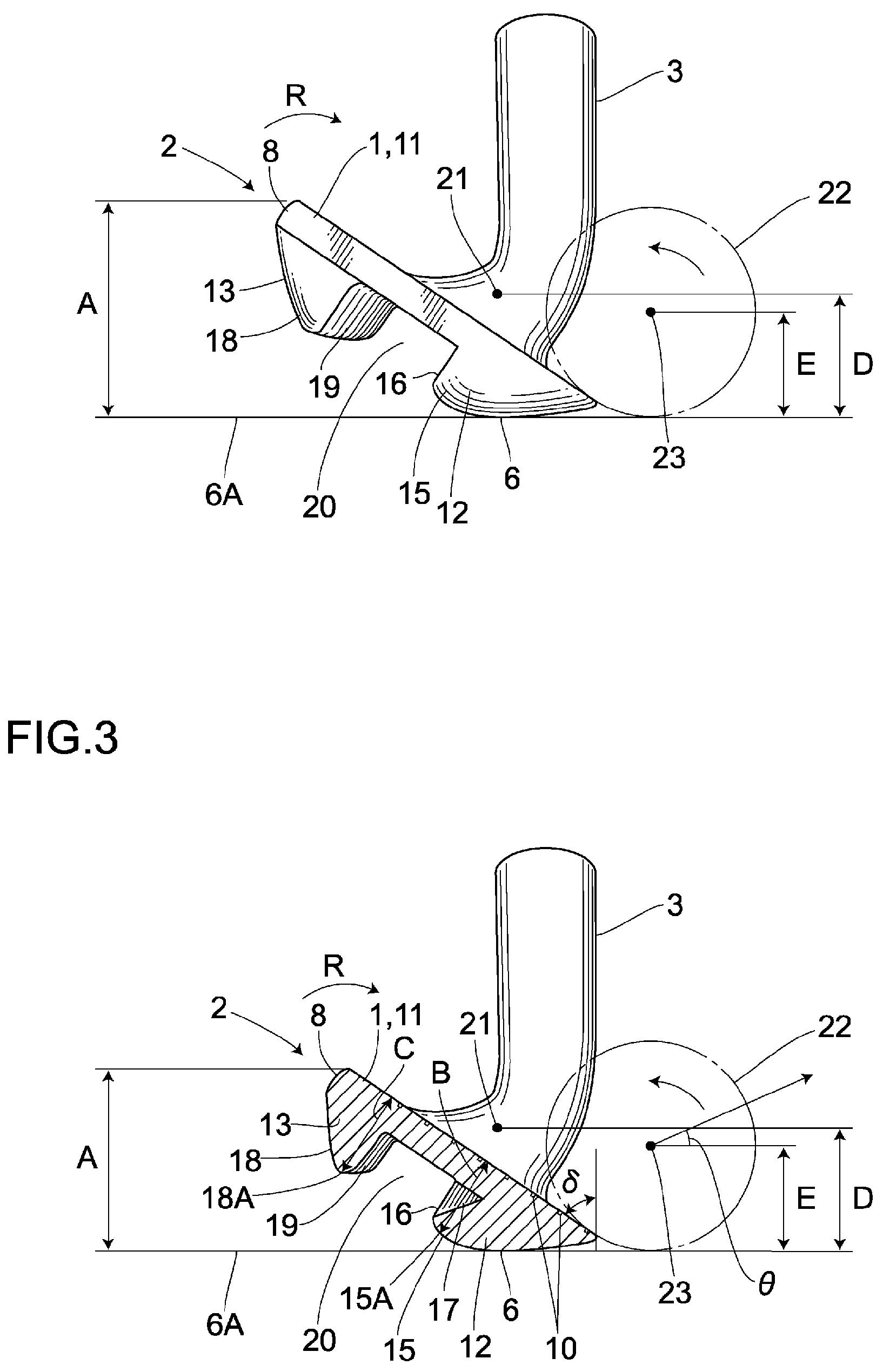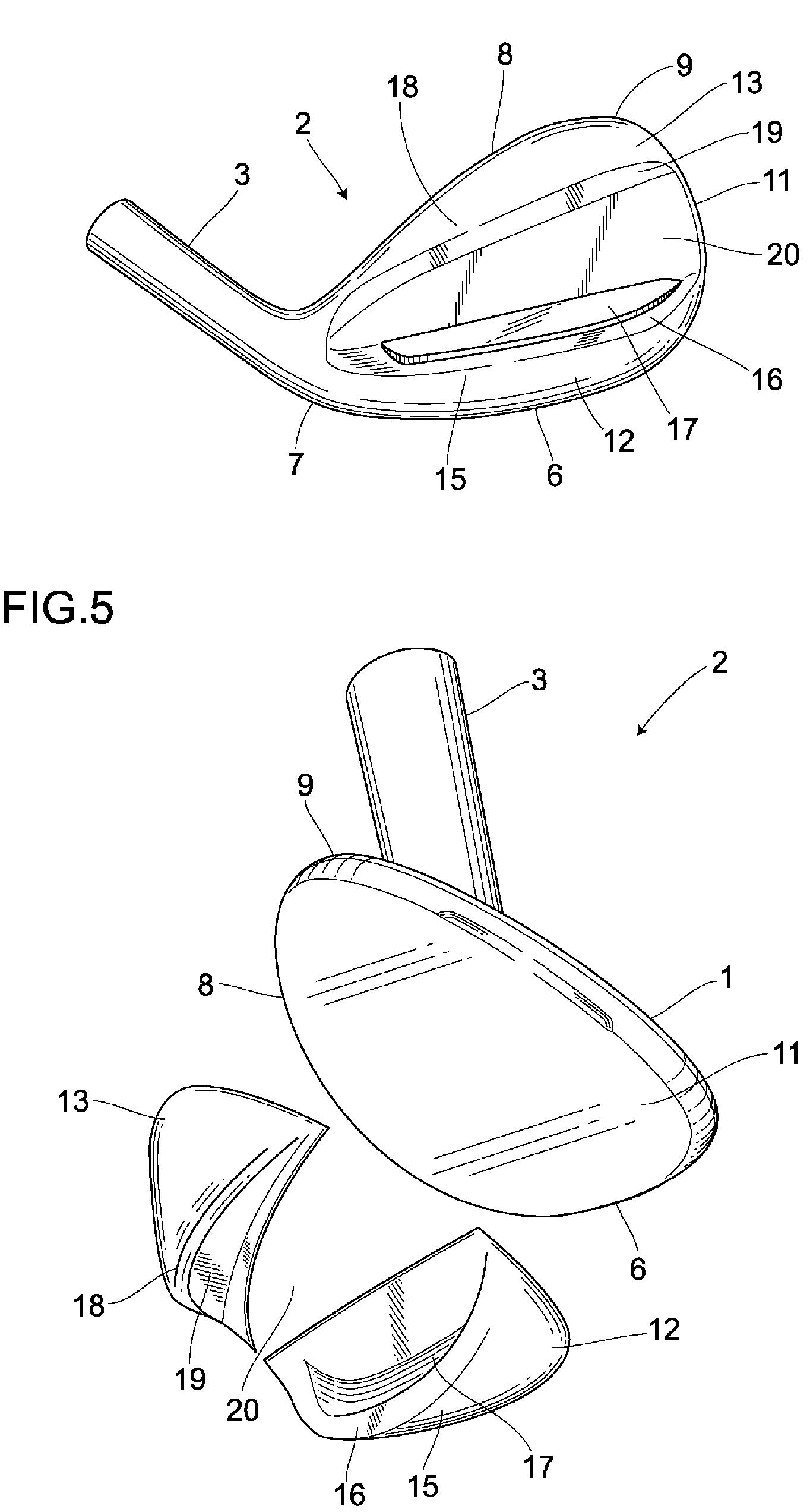How Is a High Spin Wedge Designed Without Concern for the Grooves?
Well, I have no idea…. but I will tell you how Japanese club maker K.K. Endo Seisakusho says they can do it; namely, by going against conventional thinking regarding the location of a club head’s center of gravity (CG).
Would you ever think that raising the center of gravity of a wedge head would result in more spin? Well, a recently published patent application indicates that increasing the CG height of the wedge above the center of the ball can increase the resulting spin on the ball. The application published as US Pub. No. 20090176596 titled “Wedge Type Golf Club Including Pitching Wedge, Approach Wedge, and Sand Wedge,” and the following drawings nicely illustrate the height of the club head CG versus the center of the golf ball.


The application explains:
[0012] To eliminate the above problems, it is therefore, an object of the invention to provide a golf club having a head with a face surface formed with score lines and a shaft connected with the head, which enables a strong backspin to be applied without the aid of the face surface having the score lines.
[0013] An aspect of the present invention is a wedge-type golf club, including a pitching wedge, an approach wedge and a sand wedge, comprising: a head having a sole face provided in a lower portion that acts as a ground contact surface, a face surface acting as a ball striking surface, provided on a front of said head with a certain loft angle, a shaft connecting portion on one side thereof, multiple score lines formed on the face surface of said head, and a shaft connected to said shaft connecting portion,
[0014] wherein a height of the center of gravity of said head is at least 21.335 mm and greater than a radius of a golf ball, the height of the center of gravity of said head being defined as a distance from a horizontal plane flush with the sole face of said head to the center of gravity of said head;
[0015] the center of gravity of said head is provided at an anterior position to said face surface, and
[0016] wherein for the score lines as measured, 50% or more of the measured values of X divided by the pitch of the score line are less than or equal to 0.0030” (0.0762 mm.sup.2/mm), where X denotes a traverse cross section of a groove per one score line, and the pitch of the score line is defined by the sum of the groove width and the groove separation.
[0017] Thus, the center of gravity of the head is positioned in a higher position than the center of a golf ball at the time of hitting a shot, and thus the face surface is allowed to rotate downward or clockwise due to the ball impact thus imparted, so that so-called gear effect is generated to thereby be able to accelerate the backspin of the ball even if the face is the one in which the backspin is hard to accelerate.
[0018] Further, as the above structure is employed for wedge type golf club, an approach shot from around a green can be preformed correctly.[0019] Also, it is possible to ensure a height distance greater than a radius of a golf ball regulated under the current golfing rules.
[0020] Still also, as the center of gravity is arranged in a position anterior to the face surface, a ball striking angle at the time of hitting a golf ball can be decreased.
[0021] Another aspect of the present invention is a wedge-type golf club as set forth in the foregoing aspect, wherein an upper protrusion and a lower protrusion are provided spacedly rearwardly of upper and lower positions of said head, respectively such that a distance between a rear end of said upper protrusion and said face surface is greater than a distance between a rear end of said lower protrusion and said face surface.
[0022] Accordingly, the height of the center of gravity of the head measured with reference to the horizontal plane flush with the sole surface of the head is arbitrarily adjustable due to the adjustment of the weight distribution between the upper and lower protrusions.
[0023] A further aspect of the present invention is a wedge-type golf club set forth in the foregoing aspect, wherein an upper protrusion and a lower protrusion are provided spacedly rearwardly of upper and lower positions of said head, respectively, and the lower protrusion includes a depressed portion formed on an upper surface thereof.[0024] Accordingly, it is possible for the lower protrusion to decrease the weight corresponding to the depressed portion, thus enabling the position adjustment of the center of gravity of the head to be carried out even more easily.
[0025] A still further aspect of the present invention is a wedge-type golf club set forth in the foregoing aspect, wherein said loft angle is set at 52 to 56 degrees, and the center of gravity of said head is arranged in a position anterior to the face surface, but posterior to a distal end of the sole face.
[0026] Accordingly, the face surface is allowed to rotate downward or clockwise due to the ball impact thus imparted, so that so-called gear effect is generated to thereby be able to accelerate the backspin of the ball.
[0044] In addition, a maximal backward protruding length of the upper protrusion 18 in the rear lower portion 13, i.e., a distance C between a rear end 18A of the upper protrusion 18 and the surface of the face surface 1 is made larger than a maximal backward protruding length of the lower protrusion 15 in the rear upper portion 12, i.e., a distance B between a rear end 15A of the lower protrusion 15 and the surface of the face surface 1 (B<C). Thus, the volume or eventually the weight of the rear lower portion 12 is made less than the volume or eventually the weight of the rear upper portion 13. As a result, a height D of the center of gravity 21 of the head 2 measured with reference to the sole face 6 or the horizontal plane 6A of the sole face 6 is formed larger than that of the center 23 of a golf ball 22 to be hit by the face surface 1. Namely, the shortest length between the center of gravity 21 of the head 2 and the sole face 6 or the horizontal plane 6A of the sole face 6 is greater than a radius E of the golf ball 22. Since the golf ball 22 is required to have a diameter of 42.67 mm according to the current Golf Rules, the height (distance) D is set larger than the radius E of 21.335 mm. In the meantime, the height D does not exceed the height A of the face surface.
[0045] In a preferred form of the invention, the height D may be set at 23 mm, for example. This means that the center of gravity 21 of the head 2 is raised by about 13 to 16% as compared with the conventional ones since they were in the order of 19.8 mm or 20.4 mm.
[0074] Next is a description of a function of the above-structured golf club. In the case of using a wedge-type golf club among the above-described iron-type golf clubs to hit a pitch shot, the downswing of the golf club is carried out so that the head 2 is moved in an arc orbit in a manner thrusting into the underneath of the golf ball 22. At that moment, the face surface 1 contacts the golf ball 22 so as to get into the underneath thereof and then hits the golf ball 22. As a result, as shown in FIGS. 2 and 3, the golf ball 22 is caught in the edge portions 10A of the score lines 10 to be rotated counterclockwise, so that the backspin is applied to the golf ball 22. Furthermore, when the golf ball 22 and the head 2 strike against each other at the time of hitting the golf ball 22, the center of gravity 21 is allowed to be located higher than the center 23 of the golf ball 22, and thus the face surface 1 instantaneously withdraws its sole face 6 side
and raises its face surface 1 to thereby be rotated in the clockwise direction R. In other words, instantaneously the loft angle .delta. (delta) is decreased and as a result, the golf ball rubbed against the face surface 1 by the rotating motion of the face surface 1 is spun up in a direction reverse to the rotation of the face surface 1, so that the so-called gear effect is generated to accelerate the backspin.[0075] Further, at the time of hitting the golf ball 22, the height D of the center of gravity 21 is larger than the radius E of the golf ball 22 and further the center of gravity 21 of the head 2 is provided in a position anterior to the face surface 1. Hence, as the center of gravity 21 thereof is located higher than the center 23 of the golf ball 22 at the time of hitting a shot, the golf ball 22 is allowed to fly comparatively low at an initial stage. More specifically, an initial flying-out angle .theta. (theta) of the golf ball 22 is diminished. Thus, the golf ball 22 becomes easy to be caught in the edge portions of the score lines 10 to be able to effectively apply backspin to the same. On the contrary, if the height D is smaller than the radius E of the golf ball 22, then the center of gravity 21 would be located lower than the center 23 of the golf ball 22. Hence, the initial flying-out angle .theta. would be increased so that the golf ball 22 become hard to be caught in the edge portions of the score lines 10, thus making it difficult to apply the backspin thereto.
Are you a believer?
Dave Dawsey – Watching Golf Wedge Patents
PS – check out additional wedge related inventions here, here, here, here, here, here, here, here, here, here, here, and here
